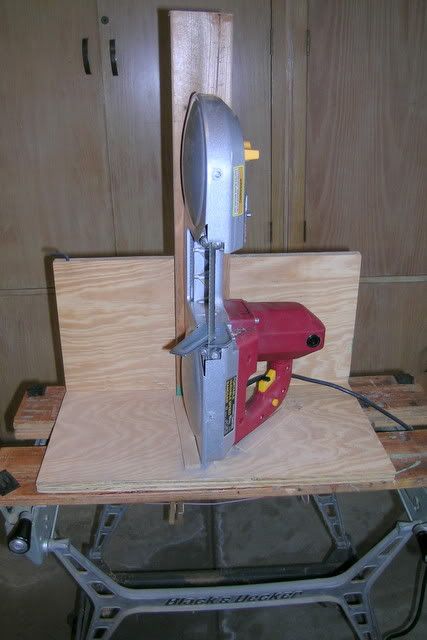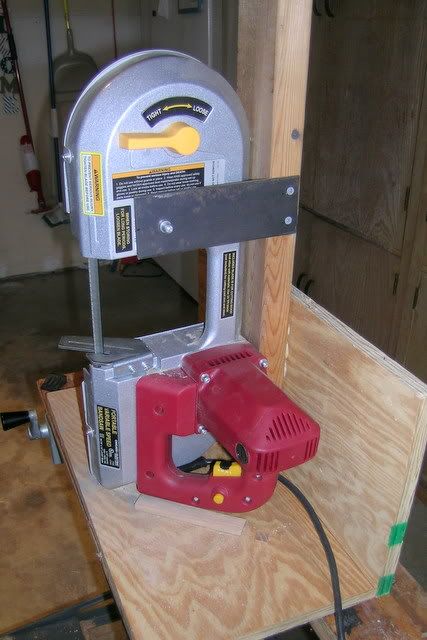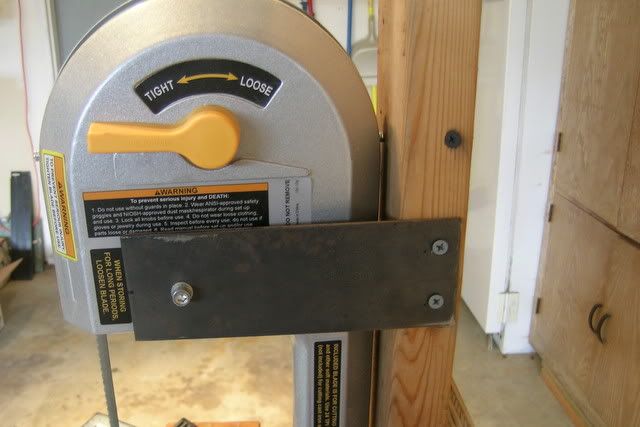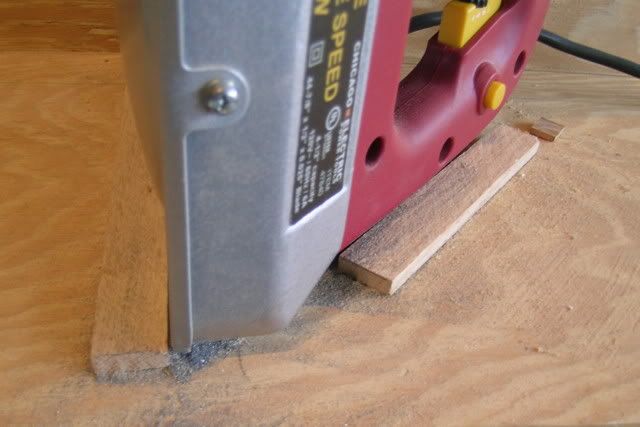NJStricker
Well-Known Member
Love or hate Harbor Freight, a lot of us that are hobby makers turn to them for inexpensive tools when operating a shop on a tight budget, especially if you are just starting out.
I've tried a variety of ways of cutting out knife blanks from bar stock. Angle grinder, drilling holes, etc. I finally decided that cutting out blanks was probably the slowest step in the knife making process for me, and decided to get a small bandsaw capable of cutting steel that would fit in my shop, which is basically part of my back yard shed. While I can buy more expensive bandsaws and ones that would probably last me longer, like many I had only so much money to play with and had other supplies to get also. So, I picked up a portable bandsaw from Harbor Freight, sold under their Central Machinery brand. It's variable speed (you can crank it down low enough to cut steel), you can find better quality bimetal blades for it, and if you watch for sales and coupons you can get it for WAY under $100.
This bandsaw is meant to be held by hand for cutting through tubing, etc. HF has a video on its website of one in use. But for cutting out knife blanks I need it to sit vertically.
So, here is a simple stand I made up with some scrap pieces of 3/4 inch plywood and a 2x4:

I can clamp this stand to my Workmate, to the workbench in my shed, or even mount it with lag screws to the studs in a wall--so it gives you several options.
The stand isn't anything fancy--a bottom and back made of the plywood that is fastened with Gorilla glue and screws, and a 2x4 post that serves as an attachment point for the bandsaw itself.

This particular bandsaw has a handle that you can remove by taking out 2 allen-head bolts. I removed the handle and use these bolts (I'm only using 1 currently) as the mounting point between the bandsaw and the upright post. I have a strip of mild steel acting as the mounting bracket.

I added a couple of cleats at the bottom by gluing some thin wood strips at the base of the saw. These are glued to the wood base of the stand, and are positioned so that the bottom of the saw does not shift.

The saw can be removed off the stand simply by taking out the handle bolts from the mounting bracket, replacing the handle, and it's all ready to go for its original intent or if you have to change out blades, etc. If you run the bandsaw in the upright position with the housing cover over the wheels/blade, you'll need to take it off occasionally to clean out any debris since the saw was not designed to run vertically.
But, for me it is working so far. The blade that comes with the saw is a bit coarse at 14TPI and isn't the best, but I did manage to cut out 4 blanks before I chipped a couple of teeth. I'll soon be switching the blade out to a 24TPI bimetal blade. Knowing that this isn't the higher dollar work horse that the Milwaukee or DeWalt is, I take my time feeding the steel through and don't try to hog it. On tiny pieces I don't cut all the way though, that way they don't drop down and interfere with the lower wheel. I still need to fabricate a bigger table for this, but for small stuff it's working OK so far.
These were all cut from 1/8 inch 1080 bar stock. From top to bottom is a boot knife, 2 small Kepharts, and a bird & trout. From here I'll take a file to clean up the profile, drill pin holes in the handles, then start grinding.

Thanks for looking!
I've tried a variety of ways of cutting out knife blanks from bar stock. Angle grinder, drilling holes, etc. I finally decided that cutting out blanks was probably the slowest step in the knife making process for me, and decided to get a small bandsaw capable of cutting steel that would fit in my shop, which is basically part of my back yard shed. While I can buy more expensive bandsaws and ones that would probably last me longer, like many I had only so much money to play with and had other supplies to get also. So, I picked up a portable bandsaw from Harbor Freight, sold under their Central Machinery brand. It's variable speed (you can crank it down low enough to cut steel), you can find better quality bimetal blades for it, and if you watch for sales and coupons you can get it for WAY under $100.
This bandsaw is meant to be held by hand for cutting through tubing, etc. HF has a video on its website of one in use. But for cutting out knife blanks I need it to sit vertically.
So, here is a simple stand I made up with some scrap pieces of 3/4 inch plywood and a 2x4:

I can clamp this stand to my Workmate, to the workbench in my shed, or even mount it with lag screws to the studs in a wall--so it gives you several options.
The stand isn't anything fancy--a bottom and back made of the plywood that is fastened with Gorilla glue and screws, and a 2x4 post that serves as an attachment point for the bandsaw itself.

This particular bandsaw has a handle that you can remove by taking out 2 allen-head bolts. I removed the handle and use these bolts (I'm only using 1 currently) as the mounting point between the bandsaw and the upright post. I have a strip of mild steel acting as the mounting bracket.

I added a couple of cleats at the bottom by gluing some thin wood strips at the base of the saw. These are glued to the wood base of the stand, and are positioned so that the bottom of the saw does not shift.

The saw can be removed off the stand simply by taking out the handle bolts from the mounting bracket, replacing the handle, and it's all ready to go for its original intent or if you have to change out blades, etc. If you run the bandsaw in the upright position with the housing cover over the wheels/blade, you'll need to take it off occasionally to clean out any debris since the saw was not designed to run vertically.
But, for me it is working so far. The blade that comes with the saw is a bit coarse at 14TPI and isn't the best, but I did manage to cut out 4 blanks before I chipped a couple of teeth. I'll soon be switching the blade out to a 24TPI bimetal blade. Knowing that this isn't the higher dollar work horse that the Milwaukee or DeWalt is, I take my time feeding the steel through and don't try to hog it. On tiny pieces I don't cut all the way though, that way they don't drop down and interfere with the lower wheel. I still need to fabricate a bigger table for this, but for small stuff it's working OK so far.
These were all cut from 1/8 inch 1080 bar stock. From top to bottom is a boot knife, 2 small Kepharts, and a bird & trout. From here I'll take a file to clean up the profile, drill pin holes in the handles, then start grinding.

Thanks for looking!
